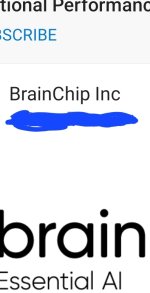Fullmoonfever
Top 20
Just found this LinkedIn post by QV from several months ago on their paper re Cyber-Neuro RT.
Was the comment I found interesting.
I "hope" he gets the chance too

 in.linkedin.com
in.linkedin.com

Quantum Ventura Inc.
196 followers
7mo
We're proud to share a recent paper from our group on machine learning for cybersecurity, done under a DOE contract. Detecting malicious network traffic was shown with full precision and neuromorphic deep neural networks with good accuracy. Much more to come as we scale this system for larger datasets, updated models, etc.! Please contact Aaron Goldberg for more details! Thank you Wyler Zahm, Tyler Stern, Malyaban Bal, Abhronil Sengupta, Aswin Jose, Suhas Chelian, and srini vasan for the awesome work! #machinelearning #deeplearning #cybersecurity #neuromorphic


 18 1 Comment
18 1 Comment
LikeComment
Share

Ganesan Narayanasamy
Senior Technical Computing Solution and Client Care Manager at IBM
7mo
Congratulations team hope to run this solution on POWER systems
Like
Reply
4 Reactions

 www.insight.com
www.insight.com
IBM Power Systems™ are designed to sustain the most demanding, data-intensive computing on earth. Through superior core performance and memory bandwidth, the servers deliver incredible functionality enhanced by industry-leading reliability and security.
They feature leading accelerator technology for fast adoption of AI and high-performance computing applications.
IBM accelerated Power Systems equip you to face challenges head-on with NVIDIA® Tesla V100 — the only architecture with NVIDIA NVLink®. By eliminating barriers between CPU and GPU, this IT infrastructure positions you to embrace enterprise AI.
Was the comment I found interesting.
I "hope" he gets the chance too
Cyber-Neuro RT | Quantum Ventura Inc.
We're proud to share a recent paper from our group on machine learning for cybersecurity, done under a DOE contract. Detecting malicious network traffic was shown with full precision and neuromorphic deep neural networks with good accuracy. Much more to come as we scale this system for larger...
Quantum Ventura Inc.
196 followers
7mo
We're proud to share a recent paper from our group on machine learning for cybersecurity, done under a DOE contract. Detecting malicious network traffic was shown with full precision and neuromorphic deep neural networks with good accuracy. Much more to come as we scale this system for larger datasets, updated models, etc.! Please contact Aaron Goldberg for more details! Thank you Wyler Zahm, Tyler Stern, Malyaban Bal, Abhronil Sengupta, Aswin Jose, Suhas Chelian, and srini vasan for the awesome work! #machinelearning #deeplearning #cybersecurity #neuromorphic
LikeComment
Share
Ganesan Narayanasamy
Senior Technical Computing Solution and Client Care Manager at IBM
7mo
Congratulations team hope to run this solution on POWER systems
Like
Reply
4 Reactions

IBM Infrastructure | Servers, Storage, Networking
Explore IBM infrastructure solutions with Insight, from servers to storage. Get AI-ready infrastructure that protects and powers hybrid cloud operations.
Power your enterprise.
As new technologies emerge, workloads become more complex, data sets grow and the need for agile infrastructure becomes more important. Are your servers up to the challenge? With IBM, you don’t have to wonder.IBM Power Systems™ are designed to sustain the most demanding, data-intensive computing on earth. Through superior core performance and memory bandwidth, the servers deliver incredible functionality enhanced by industry-leading reliability and security.
Intelligent infrastructure
Build the foundation to enable modern analytics, machine learning and Artificial Intelligence (AI). Accelerated servers from IBM are created for speed and scale.They feature leading accelerator technology for fast adoption of AI and high-performance computing applications.
IBM accelerated Power Systems equip you to face challenges head-on with NVIDIA® Tesla V100 — the only architecture with NVIDIA NVLink®. By eliminating barriers between CPU and GPU, this IT infrastructure positions you to embrace enterprise AI.















